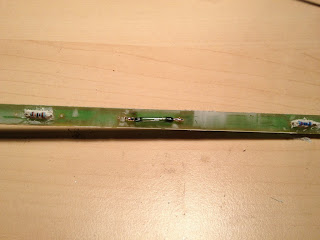Just because it's made in Germany doesn't mean it is good. It is the case with Brunnhilde's fresh water level sensor. Westfalia has been using a similar sensor for a long time now, ever since the Vanagon Camper. The one in my a few months to 25-year old Vanagon Camper still works but not the one in Brunnhilde.
Although I never disected one I inferred that the sensor is based on a number of reed switches with a float that contains a magnet. As the water level changes the float activates one or more reed switch(es). The activation of the reed switch(es) changes the resistance across the sensor terminus. This conveys to the display the water level. While the principle is quite simple there is some mind twisters as I would come to find out.
The failure mold in mine is the display panel always indicate a full tank. I inspected the sensor and I can see many hair line cracks on the plastic tube that contains the reef switches and resistors. I suck at the cracks with my mouth to see which one leaks but I cannot detect obvious leak. However I know my crude test would not detect minute crack that allow water entrance that can cause corrosion.
i cut open the sensor tube using a dremel tool with a mini cutting disc - i was careful to preserve the PCB; the entire PCB is potted in a silicone latex caulking
i carefully cut away the caulking with a sharp utility knife; there are only 3 reef switches to convey 4 possible levels - very clever and optimized design
Pretty soon I was able to determine the circuit. The reed switches are all normally open type. S1 and S2 both became defective from corrosion caused by water. It may seems reed switches with the contact enclosed in a hermetically sealed glass case would be quite immune to water. The truth is they fail very rapidly when exposed to moisture because the terminus corrode readily and it became the weak link of the failure mode.
The mind bender is with the magnetic field caused by the float the magnet will only activate the reed switch within its field. With this sensor the reed switch are quite far apart. The distance between S1 and S2 is the greatest because there is actually a spot (called stuffing option) for a reed switch that is not installed. When the magnet is between two reed switches it would appears to the display panel that the tank is empty. For this not to be the case the reed switch has to be very sensitive. I know they cannot be made so. So how does the designer work around this challenge?
i scrounge through my electronic junk pile looking for relays with reed switch - it been so long since I use them I had a hard time remember where I might find them
eventually i managed to find three types but one (the blue one below) turns out to be normally close type; the second one looks too delicate to be open intact
success! i found these security sensors
it has the right normally open reed switch inside and the same 14mm body size
The replacement reed switches have very poor sensitivity and it only activates when I place the float right next to it. I know I can order more sensitive reed switches from digikey for ~$0.6 each. I still have to resolve the puzzle how does the design maintain the closure of one switch while activating the adjacent one.
yes, my test show that for the display panel to show change of water level it has to maintain the closure of one switch while activating the adjacent one
at the mean while the chinese made Dorman turbo resonator arrived; peeking the inside it is built like an exhaust resonator





















Hello!
ReplyDeleteThe old level sensor was simpler made, consisted of three floats and did not need silicone. Empty space exposed it to flooding but is easier to repair.